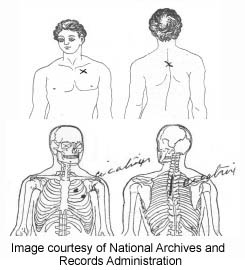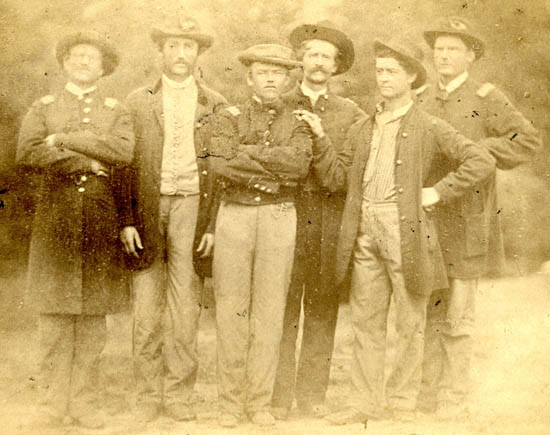William H. Mengel Diary

Image courtesy of Wilson’s Creek National Battlefield
William H. Mengel was born in Hessen Cassel, Germany on Feb. 13, 1838. He came to American with his parents in 1847, and by 1850 Mengel was living in St. Louis with his mother and two sisters. Mengel moved to California, Missouri in 1859 and worked as a clerk in H.C. Finke’s store. California was located in the Little Dixie region of Missouri, which strongly supported the Confederacy and Missouri’s Pro-Secession Governor, Claiborne Fox Jackson. When the Civil War began, men in the central region of the state certainly felt pressure to join the Missouri State Guard. According to his diary and the History of Moniteau County, Missouri, when the California Guards company of the Missouri State Guard left the county for Boonville, Mengel was one of the “non-Jackson men” who were pressed into service as a teamster with MSG.
Mengel was soon released from the Missouri State Guard, and on June 14 joined the Union Army as a first sergeant in Captain Theron M. Rice’s Company G, 1st U.S. Reserve Corps, Missouri Home Guards. Six days later, he received orders to march to Jefferson City and then to Otterville to capture a Rebel camp.
Jackson abandoned Jefferson City in May 1861. He marched south to join forces with Sterling Price, leading the Missouri State Guard. During the summer, Confederate forces scored victories at the Battles of Carthage and Wilson’s Creek. After Wilson’s Creek, on August 10, Price led the Missouri State Guard north towards Lexington, Missouri.
On August 15, Mengel and the 1st Illinois Cavalry also marched towards Lexington and captured three rebels. He was promoted to second lieutenant the following day. Mengel received orders on September 7 to “take Charge of the steam boat Clara Belle and take here to Lexington Mo. The boat being loaded with provisions for troops in Boonville [Missouri] & also Coffee sugar & salt for Lexington.”1
 Mengel arrived in Lexington on September 11, and camped with the Union forces near the Masonic College. Price’s Missouri State Guard reached Lexington two days later, and his numbers had swelled by several thousand men. Price laid siege to the town and eventually surrounded the Union soldiers positioned inside the Masonic College. The Union fortified their position, but they quickly exhausted their supplies without means to replenish them. Mengel and the other Union soldiers had little food or water between September 18 and 20, and they were finally forced to surrender on September 20, 1861. During the battle Mengel was wounded when a ball entered 1 1/2 inches below his clavicle, just below the 2nd rib, passing through the lung and lodging near the spine.”2
Mengel arrived in Lexington on September 11, and camped with the Union forces near the Masonic College. Price’s Missouri State Guard reached Lexington two days later, and his numbers had swelled by several thousand men. Price laid siege to the town and eventually surrounded the Union soldiers positioned inside the Masonic College. The Union fortified their position, but they quickly exhausted their supplies without means to replenish them. Mengel and the other Union soldiers had little food or water between September 18 and 20, and they were finally forced to surrender on September 20, 1861. During the battle Mengel was wounded when a ball entered 1 1/2 inches below his clavicle, just below the 2nd rib, passing through the lung and lodging near the spine.”2
Mengle was taken prisoner and released on a parole of honor. His parole allowed him to return home, after vowing not to take up arms again. Mengel returned to California, but enlisted as a first sergeant in the 26th Missouri Infantry on October 4, 1861, and was mustered into service on January 9, 1862.3 Several months passed between Mengel’s diary entries. His next entry was on February 16, 1862 as his regiment left St. Louis for Cairo, Illinois. They traveled on the railroad to Charleston, Missouri and skirmished with General Jeff Thompson’s men. He participated in the assault on New Madrid, and noted the Confederate retreat on March 14.4
The Battle of New Madrid was part of a larger campaign to capture Island number 10 located in the Mississippi River near New Madrid. Mengel noted the opening artillery barrages at Island Number 10, March 17. When Island No. 10 finally fell on, April 8, the Confederacy relinquished complete control of the Mississippi River to the Union. The Union Army and Navy could then navigate supplies and men from St. Louis to Vicksburg, Mississippi with little contest.
The 26th Missouri Infantry pushed further into Tennessee as the Union cavalry drove Confederate forces from the area. They reached Pittsburg Landing, Tennessee on April 23 and seven days later marched within two miles of the enemy line at Corinth, Mississippi. The Siege on Corinth lasted from April 29 through June 10, 1862, though bombardment did not really begin until late May. By May 25, the Union line was entrenched on high ground within a few thousand yards of the Confederate fortifications. From that range, Union guns shelled the Confederate defensive earthworks, and the supply base and railroad facilities in Corinth. Confederate General P.G.T. Beauregard was outnumbered two to one, and was losing men daily to typhoid and dysentery. At a council of war, the Confederate officers concluded that they could not hold the railroad crossover.
Mengel recorded that the 26th Missouri Infantry captured seven pieces of Rebel artillery on May 28, the day before Beauregard and the Rebels evacuated Corinth.5 During the night of May 29, the Confederate army utilizing the railroad retreated from the crossroad town. The Confederate soldiers set up dummy (“Quaker”) guns along the defensive earthworks and kept the camp fires burning. Buglers and drummers remained behind playing through the night as the rest of the command slipped away undetected. When Union patrols entered Corinth on the morning of May 30, they found the Confederates gone.
The 26th Missouri Infantry continued to progress through Mississippi skirmishing with Rebel forces. On September 19, 1862 they entered the Battle of Iuka, Mississippi. Nine men from Company G were killed, wounded or missing.6 The Union spent the following day burying their dead comrades. The 26th Missouri Infantry remained in Mississippi until December of 1862.
Mengel heard rumors of an attack on Holly Springs, and the division marched to Oxford, Mississippi on December 21. Five days later the 26th Missouri Infantry left Mississippi for Memphis. The roads were extremely wet and muddy, which made terrible marching conditions. The men’s boots stuck in the mud and slowed their progress.7 That night, the division slept without tents as the rain poured down on the men. The men finally reached Memphis on December 29; which Mengel wrote the following day, “Kicking up He-l in Memphis.”8 The 26th Missouri Infantry left Memphis on December 31 and marched toards Grand Junction, Tennessee. Mengel stopped writing daily entrees in his diary on December 30, 1862. The 26th Missouri Infantry continued their campaign to the south participating at the Battle of Vicksburg and the Siege of Savannah, eventually the unit was mustered out of service on August 13, 1865.
After the war, Mengel married Elizabeth Meyers on December 24, 1865. The couple had seven children, and Mengel entered the lumber business. Years after the war, Mengel filed for an increase in his pension because of the injuries he sustained during his service in the army. Due to his wounds at Lexington, he had difficulty breathing when lying down and pain when reaching above the head. In early 1917, William Mengel became ill and passed away on February 20.9
Contributed by Wilson’s Creek National Battlefield
- William H. Mengel Diary, August 7, 1861. WICR 30024, Wilson’s Creek National Battlefield, Republic, Missouri.
- William H. Mengel, http://freepages.military.rootsweb.ancestry.com/~the26thmo/bios/biomengel_william.htm
- William H. Mengel Diary, Feb. 16, 1862. WICR 30024, Wilson’s Creek National Battlefield, Republic, Missouri.
- William H. Mengel Diary, March 10, 1862. WICR 30024, Wilson’s Creek National Battlefield, Republic, Missouri.
- William H. Mengel Diary, May 30, 1862. WICR 30024, Wilson’s Creek National Battlefield, Republic, Missouri.
- William H. Mengel Diary, September 19, 1862. WICR 30024, Wilson’s Creek National Battlefield, Republic, Missouri.
- William H. Mengel Diary, December 23, 1862. WICR 30024, Wilson’s Creek National Battlefield, Republic, Missouri.
- William H. Mengel Diary, December 27 and 28, 1862. WICR 30024, Wilson’s Creek National Battlefield, Republic, Missouri.
- William H. Mengel, http://freepages.military.rootsweb.ancestry.com/~the26thmo/bios/biomengel_william.htm














